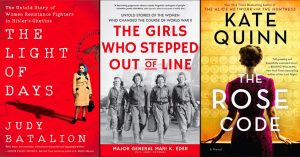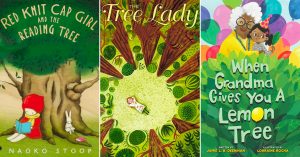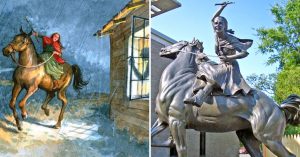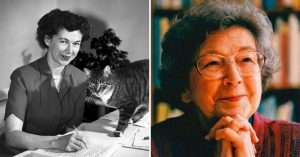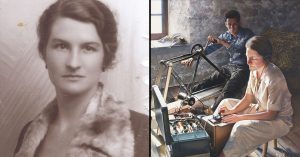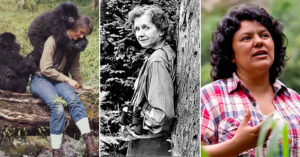By Katherine Handcock, A Mighty Girl Communications Specialist
Happy Earth Day! Around the world today, people are taking action to help protect our environment. By demonstrating responsible, green practices today, we hope to inspire people to make environmentally friendly choices throughout the year.
In honor of this day dedicated to awareness and action, A Mighty Girl is sharing the stories of ten female environmental heroes. These girls and women — scientists, activists, and innovators — have each done something that makes us see protecting the Earth a little differently. These heroes are from both past and present; some of them have acted locally, while others are influential around the world; but each of them has discovered a way that we can become better caretakers of our planet. By celebrating them, A Mighty Girl hopes that other Mighty Girls will consider ways that they can make a difference too.
For resources about the environment to share with your children, check out our earlier blogs Mighty Girls Save the World: Environmental Films Starring Girls and Women and Mighty Girls Go Green: 15 Books for Earth Day.
Jane Goodall: Groundbreaking Primatologist and Conservationist
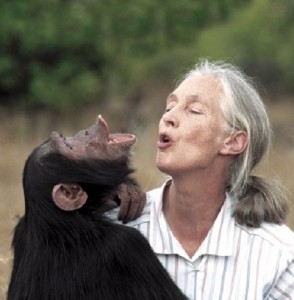 Jane Goodall with orphan chimpanzee Urahara (Photo: Michael Neugebauer)
Jane Goodall with orphan chimpanzee Urahara (Photo: Michael Neugebauer)Jane Goodall was remarkable enough for breaking into the male-dominated world of wildlife biology, and for her astonishing discoveries regarding chimpanzee behavior. However, her work to draw global attention to the protection of chimpanzee habitat, and to conservation in general, is just as remarkable! Today, just after her 81st birthday, Goodall still devotes the vast majority of her time to conservation efforts, traveling as many as 300 days a year to speak about environmental issues.
The Jane Goodall Institute, which she founded in 1977, works to help individuals around the world make informed, environmentally responsible decisions as they engage in growth and development; the Institute’s Roots and Shoots youth program, founded in 1991, began with a group of 16 teenagers and now has 10,000 groups in over 100 countries. There is no doubt that Goodall has fulfilled her self-proclaimed mission “to create a world where we can live in harmony with nature.”
If you'd like to introduce your children to Jane Goodall's incredible story, here are a few of our favorite books about this inspiring role model: The Watcher: Jane Goodall's Life with the Chimps (age 4 to 8), Me... Jane (age 3 to 8), Who is Jane Goodall (age 8 to 12), an autobiography by Goodall entitled My Life with the Chimpanzees (age 8 to 12), and a graphic novel Primates (age 12 and up).
For more books, a documentary, and other resources, visit our Jane Goodall Collection.
Wangari Maathai: Combining Conservation and Women’s Rights
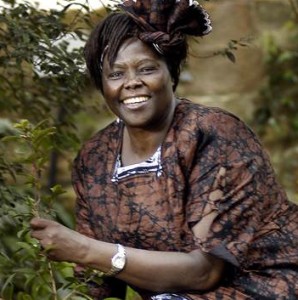 Wangari Maathai (Photo: Gianluigi Guercia)
Wangari Maathai (Photo: Gianluigi Guercia)It takes a visionary to see how ecologically friendly actions and women’s rights can go hand in hand. Wangari Maathai grew up in Kenya, but had the opportunity to pursue university studies in the US as part of the Kennedy Airlift program, which provided assistance to promising students from Africa. When she returned from her studies, Maathai saw an opportunity to help Kenyan women both protect their land and develop independence.
She founded the Green Belt Movement in 1977; the movement organizes women in rural Kenya to plant trees (to restore lost forest and to prevent land erosion) while also training them in trades like forestry, food processing, and bee keeping to encourage ongoing income and an educated approach to husbanding their lands. in 2004, Maathai received the Nobel Peace Prize for her work with the Movement, becoming the first African woman to win the award. She continued her work as founder and chair of the Greenbelt Movement until her death in 2011.
There are four excellent picture books -- all recommended for ages 4 to 8 -- on Maathai's life and work: Seeds of Change: Wangari's Gift to the World, Mama Miti: Wangari Maathai and the Trees of Kenya, Wangari's Trees of Peace: A True Story from Africa, and Planting the Trees of Kenya: The Story of Wangari Maathai.
Olivia Bouler: Artist and Bird-Lover
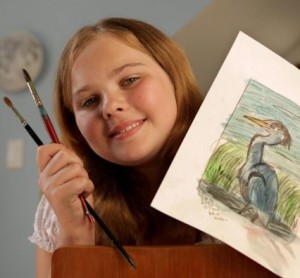 Olivia Bouler (Photo: John Paraskevas)
Olivia Bouler (Photo: John Paraskevas)Olivia proves that you don’t have to be an internationally known author or scientist to make a difference! When she was eleven years old, Olivia Bouler, who wants to be an ornithologist, was horrified and saddened to hear about the Gulf oil spill and the damage it was doing to the Gulf’s birds. She wrote a letter to the Audubon Society, “11 years old and willing to help,” and offered to auction some of her drawings with the proceeds going to Gulf recovery efforts.
To date, she has auctioned over 500 paintings and raised over $200,000! For her efforts, Olivia was named Audubon’s 2011 Artist Inspiring Conservation and the 2010 ASPCA Kid of the Year. She has also released a book, Olivia’s Birds: Saving The Gulf (age 5 - 12), which talks about Gulf recovery efforts as well as both common backyard birds and endangered bird species.
Terri Roth: Rhino Breeder
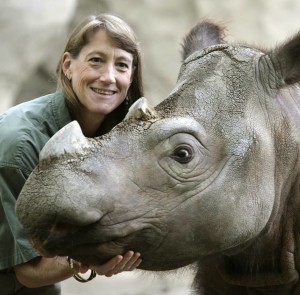 Dr. Terri Roth with Suci (Photo: Michael E. Keating)
Dr. Terri Roth with Suci (Photo: Michael E. Keating)The Sumatran rhino is the smallest rhino species in the world; it’s also one of the most endangered, since its wild population today may be lower than 100 individuals, mainly because their horns are a frequent target for poachers. Dr. Terri Roth is a reproductive biologist and the Vice President of Animal Studies at the Cincinnati Zoo and Botanical Gardens, and she was determined to accomplish a tremendously difficult feat: to help the zoo’s female Sumatran rhino, Emi, successfully carry a calf to term; Emi had previously carried five pregnancies, but all of them failed.
By studying rhino biology, Roth designed a series of hormone treatments that helped Emi birth a live male calf, the first successful birth of a Sumatran rhino in captivity in 112 years. Since then, more calves have been born in captivity, increasing the hopes that a captive breeding program could help rejuvenate the wild population.
You can read about Dr. Roth’s work and see photographs of Emi and her first calf, Andalas, in the book Emi and the Rhino Scientist, part of the Scientists in the Field series (age 10 and up.)
Rachel Carson: Creator of a Movement
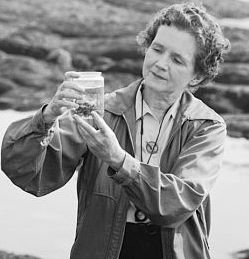 Rachel Carson with specimen jar, 1961 (Photo: A. Eisenstaedt)
Rachel Carson with specimen jar, 1961 (Photo: A. Eisenstaedt)Before the 1950s, Rachel Carson was known as a marine biologist and author of a trilogy of books about ocean life; today, though, she is famous as the author of Silent Spring, the book that brought issues of conservation and environmental protection to the forefront of the American public’s conscious. Silent Spring was published in 1962 after four years of research into the effects of pesticides on both the environment and human health.
In her book, Carson argued that indiscriminate and excessive use of chemicals risked unknown consequences to the greater ecosystem, in addition to known risks like pesticide resistance. The book generated enormous public attention to environmental issues, and became a rallying point for the developing environmental movement; it's also considered a major catalyst for the establishment of the US Environmental Protection Agency. For her work, Carson was posthumously awarded the Presidential Medal of Freedom.
To share Carson’s story with your Mighty Girl, check out the recommended books in our Rachel Carson Collection.
Dian Fossey: Defending Primates At All Costs
Alongside Jane Goodall and Birute Galdikas, Dian Fossey broke new ground for female biologists in the field when she set out to study the mysterious mountain gorillas of Rwanda. Fossey succeeded in getting close to gorillas when no one else could by imitating their behavior. The majority of her research was conducted in Rwanda's Ruhengeri province, where gorillas knew humans only as poachers, making her success at acclimating the gorillas to her presence even more remarkable.
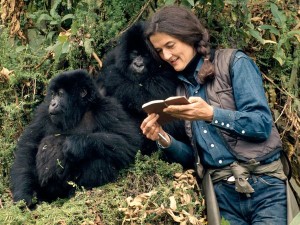 Dian Fossey (Photo: Robert I. M. Campbell)
Dian Fossey (Photo: Robert I. M. Campbell)As Fossey identified and catalogued many new aspects of gorilla behavior, she also saw the brutality of poaching first-hand. After her favorite gorilla, Digit, was killed by poachers, she founded the Digit Fund and changed her focus from behavioral research to preventing poachers. She and her staff cut traps, burned poachers' camps, and captured and humiliated hunters. She also fourght for greater legal protection for the gorillas. Sadly, Fossey was found murdered in her Rwanda cabin in 1987. Debate still rages about the identity of her killer and about the tactics she used to protect her beloved gorillas. What cannot be debated, though, is that Rwanda's gorillas would be extinct today if it had not been for her pioneering efforts.
You can learn more about Fossey in the photobiography Light Shining Through The Mist for ages 9 to 12. Fossey, along with her colleagues Goodall and Galdikas, are also profiled in the graphic novel Primates: The Fearless Science of Jane Goodall, Dian Fossey,and Birute Galdikas for ages 12 and up. A dramatization of Fossey's story is also told in the 1999 film Gorillas In The Mist for ages 13 and up, which stars Sigourney Weaver in an Oscar-nominated performance as Fossey.
Kate Sessions: Bringing Green to the City
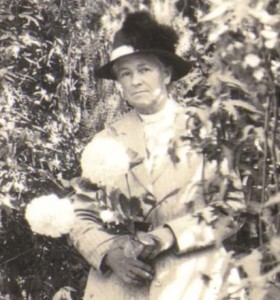 Kate Sessions, 1919 (Photo: Fairchild Tropical Botanical Archive)
Kate Sessions, 1919 (Photo: Fairchild Tropical Botanical Archive)Environmentally friendly living doesn’t just mean protecting natural spaces; it also means finding ways to create green space in towns and cities. Kate Sessions spent most of her childhood living in and around the towering trees of northern California. In 1881, she was the first woman to graduate from the University of California with a science degree, and shortly afterward she moved to San Diego — at the time, a dry city with almost no plant life. After starting her horticultural career with a nursery in 1885, Sessions arranged to lease 30 acres of land in City Park (now called Balboa Park) from the city, in exchange for planting 100 trees a year in the barren park, and 300 trees a year in the rest of San Diego. Today, her gardens and parks are still found throughout the city, and Sessions is known as “the Mother of Balboa Park.”
You can share Session’s story with your Mighty Girl in the new book The Tree Lady: The True Story of How One Tree-Loving Woman Changed a City Forever (age 5 - 10)
Sylvia Earle: Protecting Earth’s Water
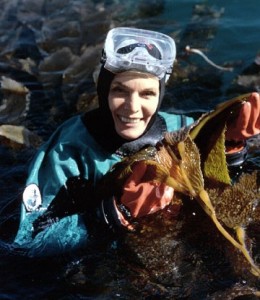 Sylvia Earle (Photo: Mission Blue)
Sylvia Earle (Photo: Mission Blue)Sylvia Earle discovered a love for the ocean — and all the creatures within it — when she was just a child, swimming in the Gulf of Mexico. It was natural that she went into oceanography, striving to reach new depths and to study the more mysterious denizens of deeper water; she even set a women’s depth record (reaching 1,250 feet) in 1979.
Earle is an explorer-in-residence for National Geographic, where she was nicknamed “Her Deepness” and “The Sturgeon General.” And in 1998, Time Magazine named her its first Hero for the Planet. In 2009, Earle won a TED prize, and used the support to found Mission Blue, an organization that is establishing protected marine areas around the globe. She continues to be dedicated to protecting “the blue heart of the planet,” the still mysterious — but critically important — water systems of the world.
Your children can learn more about Earle in in the beautifully illustrated picture book Life In The Ocean: The Story of Oceanographer Sylvia Earle (age 4 - 8), or in Earle’s own book Dive: My Adventures In The Great Frontier (age 8 - 12).
Isatou Ceesay: Combining Environmental Awareness and Job Creation
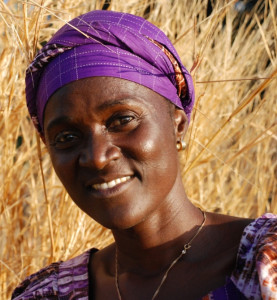 Isatou Ceesay
Isatou CeesayIn the states of Gambia, people threw away plastic bags like they used to throw away their woven baskets; but unlike the baskets, the bags never decomposed. Isatou Ceesay saw the many problems the plastic bags were causing -- the mounds of garbage building in the streets, the stagnant water gathering in the bags and making breeding grounds for mosquitos and other disease-carrying insects, and the foul-smelling fumes when people tried to dispose of the bags by fire instead. So in 1997, she founded the Njau Recycling and Income Generation Group, determined to reduce the garbage and provide economic opportunities for local women at the same time.
This revolutionary community recycling initiative turns waste into wealth. Women collect the recyclable materials and bring them to a center where they separate out the plastics and upcycle them into bags, mats, purses, and more. Today, over 100 women gain income thanks to Ceesay's initiative, and she continues to search for innovative ideas to improve waste management in the Gambia. "I didn't call out the problem," she says. "I called out solutions."
To introduce children to Ceesay's inspiring story, check out the picture book for ages 5 to 9 One Plastic Bag: Isatou Ceesay and the Recycling Women of the Gambia.
Caitlin O’Connell: Talking To Elephants
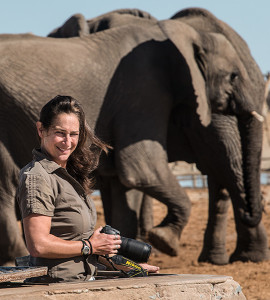 Caitlin O'Connell in Etosha National Park (Photo: Tim Rodwell)
Caitlin O'Connell in Etosha National Park (Photo: Tim Rodwell)Caitlin O’Connell had warring interests between medicine and field biology as a child; her adult life would end up combining both fields. While working on a Ph.D. in ecology in the late 1990s, O’Connell had the opportunity to travel to Namibia and study elephants in the wild in an effort to solve a serious problem: elephants were damaging fields and eating crops, sometimes destroying a year’s worth of a family’s food in a single night. O’Connell had an unusual idea: if they figured out how the elephants were communicating, perhaps they could “tell” the elephants to stay away from human settlements.
In the process, O’Connell made an amazing discovery: the elephants used seismo-acoustic communication by feeling vibrations through their feet. O’Connell still studies elephants, now exploring how lessons in elephant communication might help people with hearing impairments; she also encourages people to look at conservation as an interaction between animals and humans, saying, “You can't address wildlife issues without addressing the humans who have to live with and care for the animals.”
You can learn more about O’Connell’s work in the book The Elephant Scientist, part of the Scientists in the Field series (age 9 and up), or on her website.
Each of these amazing girls and women took a love of nature and concern for the environment and turned it into something amazing! We hope that your Mighty Girl is inspired to look at her own life for ways that she, too, can be an environmental hero.
Additional Recommended Resources
- For books about the environment to share with your Mighty Girl, check out our blog Mighty Girls Go Green: 15 Books for Earth Day, or our full selection of environment books.
- For films that featuring environment-conscious Mighty Girls and women, visit our post Mighty Girls Save the World: Environmental Films Starring Girls and Women.
- For more books about the natural world, visit our Animals / Nature section.
Help keep A Mighty Girl growing in the years ahead!
If you discover any books or other resources via this post that you would like to purchase, please use the "Buy at Amazon" link on every A Mighty Girl product page. By doing so, at no added cost to you, you help to support the site and allow us to continue providing you with wonderful girl-empowering resources. Thanks for your support!









